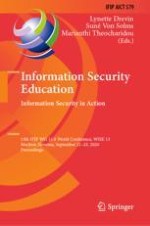2020 | Buch
Information Security Education. Information Security in Action
13th IFIP WG 11.8 World Conference, WISE 13, Maribor, Slovenia, September 21–23, 2020, Proceedings
herausgegeben von: Lynette Drevin, Suné Von Solms, Marianthi Theocharidou
Verlag: Springer International Publishing
Buchreihe : IFIP Advances in Information and Communication Technology
